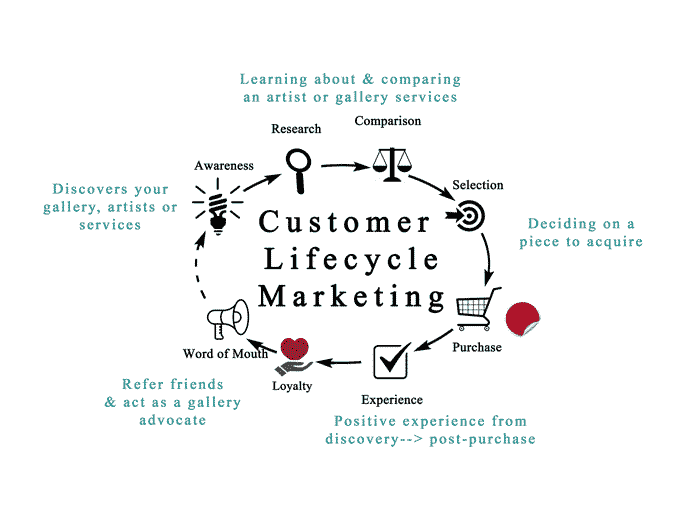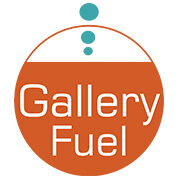Running an art gallery during a difficult economic climate is scary. Discretionary spending is often the first to go, and you know that hurts an art gallery business. So what does an action plan look like to ensure your art gallery survives?
Churchill once said, “you should never let a good crisis go to waste”. Yes… even economic uncertainty could bring opportunities with the right marketing strategy. A successful gallery that weathers the storm will act proactively. It’s the time to adjust spending and strategy to achieve optimal business results.
In this article, let’s discuss creating a gallery marketing action plan to mitigate economic challenges.
Evaluate your gallery’s best assets
The best strategy is to stick with the marketing resources you already have in place. Focus your energy on marketing efforts that are “always-on”. That might be your gallery’s website SEO, social media, an art sales platform, or even within your existing mailing list. Doing so typically has a more significant impact than trying to develop something new, flashy, and untested. Stick with what you know and focus on enhancing those resources rather than developing new ones.
Also, consider where your best art sales leads are currently coming from? As you prepare your action plan, start by identifying your top-performing opportunities and resources that are already working well and don’t carry too much financial risk. Again, you need to be able to narrow your focus and pivot your energy towards accelerating those opportunities.
Depending on what is driving the economic downturn, some lead generating sources may not be an option. For example, expensive art fairs or sales platforms may need to pause temporarily as a spending cut if sales don’t exceed the expenditures. You’ll have some soul searching to do as to what to keep and what to pause.
Lifecycle Gallery Marketing
Your “always-on” marketing efforts are put in place to move your prospective art buyers from awareness to collectors and advocates of your gallery. That is what lifecycle marketing is all about. A significant part of marketing your art gallery during a recession with lifecycle marketing is brand building with a strong value proposition. That could mean developing the brand of the gallery further with your communications or your gallery program as a whole.
The chart below shows what is at the core of lifecycle marketing for your art gallery.
 Lifecycle marketing activities you might always have working might include things like:
Lifecycle marketing activities you might always have working might include things like:
- SEO
- Social media
- Brand awareness activities
- Paid advertising
- Marketing automation for research, post-purchase or experience
- Email marketing
- Blogging for research
- Re-engagement campaigns
- Affiliate marketing or partnerships
- Referral or loyalty program
- 3rd party sales platforms
Evaluate each of the life cycle marketing activities above to determine where best to put your time and energy towards as part of your marketing plan during tight times. I encourage you to also put extra emphasis on your brand building and value proposition. Your promotion of your artists will not stop entirely, of course. But may be appropriate for it will take on a soft selling tone. We will talk more about that below.
Create an Art Gallery Recession Action plan
As part of your gallery’s plan to survive a difficult economic climate, I recommend six key steps to take. Some you may need to put into place before a crisis hits. We usually get some warning or can see the writing on the walls in a precarious economy. These strategies should help keep some income flowing to pay the bills. They should also help set the gallery up for a fantastic comeback when conditions improve.
1 – Shift your gallery’s marketing message
Your marketing messaging should shift from specifically focused on selling your artist to showcasing your gallery program and services. Elements of your gallery program and services connect with your buyer’s values and needs. Changing messaging will help you do three important things when a recession hits.
- Build gallery brand equity
- Show empathy for your clients and artists
- Cast a wider net for the awareness stage of the lifecycle
Your buyers could be struggling financially as well. Choose messaging that allows you to be empathetic of that fact and demonstrate how the gallery supports your community, your clients, and artists.
2 – Create content that is educational and entertaining
What untold (or rarely told) stories can you tell through gallery content? Plan to communicate stories that help build brand awareness and reflects value from your gallery for prospective buyers.
As you will likely reduce other marketing initiatives in a recession, content creation will become more impactful. Increasing the content from your art gallery is a soft-selling technique that could resonate better with collectors during a downturn. Mixing this kind of content in with your regular messaging around artists and exhibitions will also fit into both the awareness and research phase of your collector’s lifecycle.
Create more long-form blog posts, short videos, Instagram stories, etc. Try to increase your gallery brand forward content by at least 20%.
You don’t want to overload your email list by increasing the number of emails you send. However, you can promote your new content in your regularly scheduled newsletters.
3- Diversify Your Art Gallery’s Revenue Streams
Surviving a recession may mean creating new revenue streams. Even if only temporarily. Let’s look at some ideas for adding new revenue sources.
- Sell secondary works your collectors are ready to part with but don’t know how to go about doing so.
- Promote that gallery as a rental space.
- Offer a collection management package that would include documenting and photographing a collection to include in their estate plan.
- Develop an art rental service for commercial clients.
- Charge artists an upfront exhibition fee but take only 20–30% sales commission.
- Create paid lecture series or workshops
- Add a small shop of unique items, such as affordable jewelry or home items.
When art collectors start to tighten their wallets, it is smart to other income sources beyond art sales commissions. It will help ease the financial pressure of running the art gallery. However, as you can see some of these ideas may require putting in place in advance and a slight pivot of your business model.
4 – Adjust your art offering
Immediately after an economic downturn, your target market will prioritize paying off debts before they can consider acquiring art again. But people still want that emotional lift. They will want to treat themselves in a small way.
You may consider enabling that by offering new, less expensive artworks by your current artists. Could you temporarily introduce temporarily new emerging artists with a lower price point to you roster? As we mentioned above, unique items from a gallery shop that have a high profit margin could be easier for your target buyers to justify than buying a piece of art.
If you choose to bring in new artists, you can promote them as available for a limited time, or as a special offering that may fit better with your client’s current needs during the recession. Just ensure, of course, that the artists you select fit into the perimeters of your gallery’s program. You will also want to get feedback and recommendations from the artists you represent.
5 – Set a budget aside for gallery advertising when the recession ends
Once the recession nears an end, your gallery’s collectors will be more comfortable buying art again. This is the time to increase marketing spending beyond what is normal to catch up. Competition for those dollars will be high from many different sources.
From the moment you realize a recession is going to impact your gallery’s revenue, you need to start planning campaigns for when things go back to “normal” selling conditions. This is the time to bring back a sales tone in your marketing and to take advantage of all that good brand equity you have been building up.
6 – Gallery Emergency Fund
Lastly, create an emergency savings account. It should be separate from your regular business account. Commit to putting a little money in each month, so it is there to help you through or bounce back when the hard times are over.
Hard times will continue to happen. That’s life, right? Creating an emergency fund makes good fiscal sense.
To the Point
History shows us we cannot predict when a recession will hit and how it will impact your gallery business. Marketing an art gallery in those times takes some planning to get it right. You won’t have time to waste trying to figure out what to do once your sales dry up.
Regardless of whether a recession is caused by a financial market meltdown, war, a global pandemic, or Mother Nature wielding her power, you need a plan. A plan that can be put into action quickly and includes changes you make in advance to your business model that will strengthen your ability to survive a crisis.
Having a “go-to” plan in place will help you invest your time and money wisely during a current or future recession. Focus on only your art gallery’s best marketing channels for generating sales leads. Don’t be tempted to try something new and untested. Shift your marketing message to have an empathetic tone and showcase your gallery’s program and values.
You may want to seriously consider how you can add new revenue streams to your business. Crisis or not – that is likely a good idea for whatever the future holds.
I always want to see your gallery thrive in good times and bad. If you would like to discuss your gallery’s situation with me, let’s set up an appointment.
These articles may also be helpful.
Art Gallery Business Model: Embracing Change for Future Success



Leave a Reply